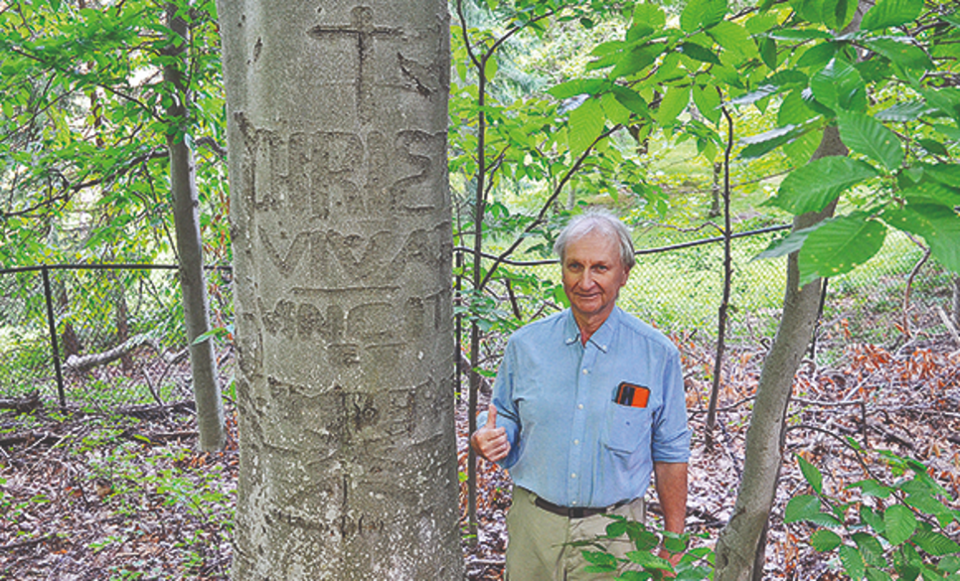More than a century ago, the religious brothers who called De La Salle College home sought solace in the woods near Yonge Street and Bloomington Road.
Amid the trees and brush, they carved out a path between their home base (what later became Pine Ridge Institute) and MaryLake in King Township, carving prayers into the smooth trunks of beech trees along their meditation route – finding calm and serenity in their surroundings.
Little of these forests remain due to the march of development, the brothers’ eastern-most route of what became known to locals as the Monk’s Walk, including just a few survivors of the carved trees, remain – hidden away behind the local detachment of the Ontario Provincial Police and Cardinal Carter Catholic High School.
Now, a group of trails enthusiasts who have dedicated their retirement to clearing the path so it can be enjoyed once again are calling on the province and Town of Aurora to step up and help local residents rediscover a trail that, it is argued, is one of the community’s most historic yet most forgotten.
“I have been going in for years trying to improve it,” says Helmut Schwarze, 87, who has been joined in this effort by trails advocate Klaus Wehrenberg and Alan Hamalainen. “More than 100 years ago, the building was inhabited by [the Brothers] and they made a trail all the way to Marylake but only the first portion, about one-kilometre long from the original start, still exists. Local residents have been using it for years, but the exits from Yonge Street are not accessible anymore. You can’t even get to where it is.”
The makeshift team, however, has taken it upon themselves to establish an equally makeshift entrance. Accessible from the northeast corner of the property, which the OPP shares with offices of the provincial government, you’d be forgiven for missing the small plank of wood with Monk’s Walk etched into it before it was staked into the ground in between sheds and storage containers, but it’s the best that can be done – for now, they say.
Schwarze says the Monk’s Walk, which is on provincially owned land, was included in Aurora Trails Master Plan in 2011 but very little has been done since.
“We need a trail extension to Yonge Street so everyone can use the trail,” he says.
Schwarze first discovered the trail about 10 years ago when, after he suffered a heart attack and endured a triple-bypass, doctors advised him to get more exercise, particularly walking.
“We walked all the available trails in Aurora and surrounding areas in York Region and somebody told me about this trail and I wanted to get to know it,” he says. “The trail was being used by school children who go to the Catholic school in the area and [their foot traffic] kept it open to a degree, but during the pandemic everything was shut down and, naturally, the thing grew in. I came together with two friends with the equipment to get rid of all the weeds, then I took red tape to mark the trail. The locals were happy about it because they were walking their dogs but couldn’t find the trail anymore. Now they can and it’s quite a job to maintain it, and the growth, especially this year, has been tremendous.”
But the ownership of the land could be a sticking point.
While the building property at the northwest corner of Yonge and Bloomington has seen many lives over the last century – from its Catholic roots as De La Salle College, to its time as the controversial Pine Ridge Institute for men with developmental disabilities, a terrible chapter now marked following a push from survivors and their families, and its more recent years as home to provincial departments and the OPP detachment – delineating responsibilities for the Monk’s Walk has been a bit murkier.
They hope to gain some traction to make the area publicly accessible again.
“I’m not religious but it intrigues me how Monk’s Walk was done; the monks only used beech trees, which have a very smooth surface, perfect for etchings in English and Latin,” says Schwarze. “There is a huge area of raspberry bushes and a huge area with edible mushrooms and the whole area is really appealing – I like it and my friends tell me they like it, too. It would be great to have something designated here and marked so people can use it. People don’t mind others using it because it keeps it clean. We have been looking after it for lots of years.”
Adds Hamalainen, “I want to encourage travel into nature for spiritual and physical well-being. It’s close to where I live, and it makes an effective and good place to just decompress. It’s also very easy to maintain once the entrance gets built.”
Brock Weir is a federally funded Local Journalism Initiative reporter at The Auroran



